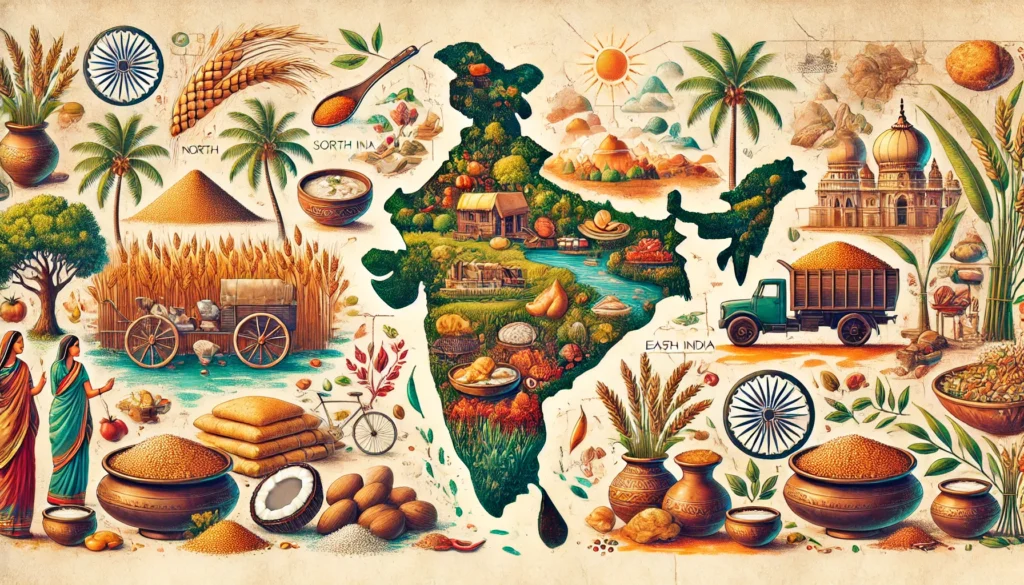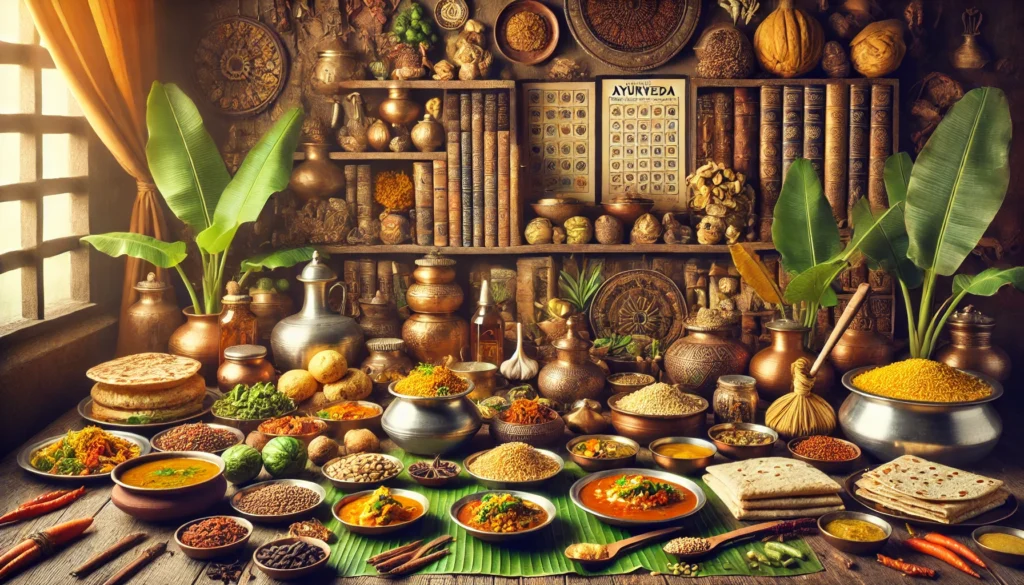- Home
- Health & Well-being
- Holistic Health
- Indian Food: Scientific and Fl ...
Indian Food: A Scientific, Logical, and Flavorful Tradition
Indian cuisine is a rich blend of flavors, science, and tradition, offering a holistic approach to health and well-being. This blog explores how Indian food, guided by Ayurvedic principles, balances nutrition and supports physical and mental health. You’ll learn about the geographical diversity that shapes regional cuisines, from the hearty dishes of North India to the light, fermented foods of the South.
We dive into the Ayurvedic foundation of Indian meals, emphasizing the importance of six essential tastes and personalized diets. The blog also highlights the role of spices like turmeric and ginger, not just for flavor but for their remarkable health benefits. Seasonal eating, a key aspect of Indian tradition, aligns dietary practices with nature, ensuring harmony and optimal health throughout the year.
Additionally, the blog touches on the modern scientific backing of traditional Indian diets, showcasing their role in managing lifestyle diseases and boosting immunity. Beyond health, Indian cuisine celebrates life, culture, and community, making every meal a shared experience of joy and connection. Finally, we provide resources for readers eager to delve deeper into the world of Indian culinary wisdom.
Let’s explore all these fascinating aspects in this very interesting blog!

Indian Cuisine: More Than Just Food
An old Indian proverb states, “Jaisa ann, waisa mann” (As is the food, so is the mind), highlighting the central role of food in maintaining physical and mental well-being. Indian cuisine’s complexity lies not only in its flavors but also in its scientific basis. Each meal is designed to provide balanced nutrition while catering to individual health needs, making it a powerful tool for maintaining health and harmony.
Geographical Influence on Indian Cuisine
India’s vast and varied geography significantly influences its culinary traditions. From the cold Himalayan mountains to the tropical coasts of Kerala, each region has developed unique cooking styles and ingredient preferences tailored to its environment. This geographical diversity is a cornerstone of Indian cuisine, ensuring that food not only nourishes but also helps the body adapt to its surroundings.
- North India: Known for its extreme winters, the region’s cuisine is rich in wheat, dairy, and warming spices. Staples like parathas, ghee-laden curries, and hearty lentils provide warmth and energy.
- South India: With a hot and humid climate, the southern states favor rice, coconut, and fermented foods. Dishes like idli, dosa, and sambhar are light, cooling, and easy to digest.
- West India: The arid regions of Rajasthan and Gujarat rely on water-efficient grains like millets and pulses. These nutrient-dense foods are paired with bold spices to create dishes like bajra roti and dal bati churma.
- East India: Influenced by its fertile plains and river systems, eastern India boasts a diet rich in rice, fish, and mustard oil. Fermented delicacies like panta bhat (fermented rice) enhance gut health.
According to Dr. Robert Svoboda, a leading Ayurvedic expert, “Indian food reflects a logical relationship between diet and environment. The geographical adaptation of cuisine ensures that each region’s food supports the local climate and lifestyle.”

The Ayurvedic Foundation of Indian Food
Ayurveda, the ancient Indian system of medicine, places significant emphasis on food as a means of maintaining health and preventing disease. It categorizes individuals into three doshas—Vata, Pitta, and Kapha—and recommends diets that balance these energies. The Ayurvedic diet is not a one-size-fits-all approach but a personalized guide to health based on one’s constitution.
Six Tastes for Holistic Nutrition
Ayurvedic meals incorporate six essential tastes: sweet, sour, salty, bitter, pungent, and astringent. Each taste serves a specific function:
- Sweet (e.g., rice, milk): Nourishes tissues and calms the mind.
- Sour (e.g., yogurt, citrus fruits): Stimulates digestion.
- Salty (e.g., sea salt, pickles): Balances electrolytes and enhances taste.
- Bitter (e.g., leafy greens, turmeric): Detoxifies and cleanses the body.
- Pungent (e.g., ginger, black pepper): Stimulates metabolism.
- Astringent (e.g., legumes, pomegranates): Supports tissue repair and reduces inflammation.
Dr. Vasant Lad, a prominent Ayurvedic practitioner, explains, “Ayurveda teaches that food is medicine. When you eat in harmony with your body type and the seasons, you enhance both physical health and mental well-being.”

The Role of Spices: Flavor Meets Function
Spices are the backbone of Indian cuisine, offering not just flavor but also significant health benefits. They have been used for centuries to enhance digestion, boost immunity, and prevent diseases.
Key Spices and Their Benefits
- Turmeric: Known for its anti-inflammatory and antioxidant properties, turmeric is a staple in Indian kitchens. It helps combat inflammation, supports joint health, and boosts immunity.
- Cumin: Often used in tempering, cumin aids digestion and prevents bloating.
- Fenugreek: Rich in fiber and antioxidants, fenugreek helps regulate blood sugar levels.
- Coriander: This versatile spice supports digestion and has cooling properties.
- Ginger: A natural remedy for colds and digestive issues, ginger is widely used in both cooking and Ayurvedic medicine.
Chef Vikas Khanna, a Michelin-star chef and advocate of Ayurvedic food practices, states, “Indian cuisine’s use of spices is a perfect blend of taste and health. Each spice has a purpose, whether it’s enhancing flavor or supporting the body’s health.”

Seasonal Eating and Festive Foods
In India, food traditions are closely tied to seasons and festivals. Seasonal eating is a fundamental Ayurvedic principle, ensuring that the body remains in harmony with nature.
- Summer: Cooling foods like yogurt, cucumber, and coconut water are emphasized to balance the body’s heat.
- Monsoon: Spices like ginger, turmeric, and black pepper are used to boost immunity and prevent infections.
- Winter: Energy-dense foods like ghee, jaggery, and nuts provide warmth and nourishment.
Festivals also bring unique food traditions. During Navratri, many people follow a sattvic (pure) diet, consuming light and detoxifying foods like fruits, nuts, and milk. This aligns with Ayurvedic practices of cleansing and renewal.
Maya Tiwari, an Ayurvedic teacher, notes, “Seasonal and festival-specific diets reflect the wisdom of our ancestors. They help detoxify the body and align it with the natural rhythms of the environment.”

Indian Food: Backed by Modern Science
The health benefits of Indian cuisine are not just rooted in tradition; they are supported by modern scientific research. A typical Indian diet, rich in vegetables, lentils, whole grains, and spices, offers a wealth of health benefits.
Key Health Benefits
- Heart Health: The use of healthy fats like mustard oil and ghee, combined with fiber-rich lentils and vegetables, supports cardiovascular health.
- Diabetes Management: Spices like fenugreek and cinnamon, along with low-glycemic foods like millets, help regulate blood sugar levels.
- Gut Health: Fermented foods such as idli, dosa, and pickles promote healthy gut flora.
- Immunity Boost: Turmeric, ginger, and garlic are known for their immune-boosting properties.
A 2020 study by the Indian Council of Medical Research (ICMR) found that traditional Indian diets significantly reduce the risk of lifestyle-related diseases, including obesity and diabetes. Nutritionist Rujuta Diwekar emphasizes, “Our traditional foods are nutrient-dense and sustainable, making them ideal for long-term health.”
Indian Cuisine: A Celebration of Life
Beyond health, Indian food is a celebration of culture, tradition, and community. Meals are often shared, fostering social bonds and enhancing the joy of eating. Festivals, weddings, and family gatherings revolve around elaborate meals, showcasing the richness of Indian culinary heritage.

Resources for Further Exploration
For those interested in diving deeper into Indian cuisine and its health benefits, the following resources are invaluable:
Books
- The Complete Book of Ayurvedic Home Remedies by Dr. Vasant Lad
- Prakriti: Your Ayurvedic Constitution by Dr. Robert Svoboda
- Indian Superfoods by Rujuta Diwekar
- Ayurveda: The Science of Food by Vikas Khanna
- The Path of Practice by Maya Tiwari
Web Portals
The Harmonious Blend:
Indian cuisine is a harmonious blend of flavor, science, and tradition. It offers a comprehensive approach to health, addressing not only physical well-being but also mental and emotional balance. Each meal is a testament to the wisdom of generations, combining the richness of spices, the principles of Ayurveda, and the joy of communal eating.
As the proverb goes, “Annadaan maha daan” (The gift of food is the greatest gift). In Indian culture, food is indeed a gift—a gift of health, connection, and celebration. Whether you are savoring a simple dal or indulging in a festive feast, you are partaking in a tradition that nourishes both body and soul.
Sources:
- Lad, V. (1998). The Complete Book of Ayurvedic Home Remedies. Harmony.
- Svoboda, R. (1998). Prakriti: Your Ayurvedic Constitution.
- Diwekar, R. (2016). Indian Superfoods.
- Tiwari, M. (2001). The Path of Practice: A Woman’s Book of Ayurvedic Healing.
- Indian Council of Medical Research (ICMR), 2020 Study on Indian Diets.

Closing Note
Indian cuisine is more than just food—it’s a celebration of nature’s wisdom, seasonal balance, and the healing power of spices and whole ingredients. Rooted in Ayurvedic principles and enriched by centuries of cultural practice, every dish carries the potential to nourish both body and mind.
While the benefits are many, it’s important to remember that wellness is personal. Exploring traditional foods with curiosity and mindfulness—while honoring individual health needs—can create a sustainable path to holistic living.
Let your plate be a place where taste meets tradition, and where every bite brings you closer to balance, vitality, and joy.




